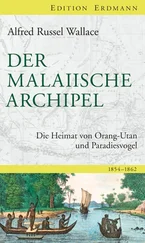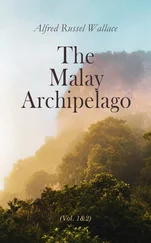Alfred Wallace - The Malay Archipelago, Volume 1
Здесь есть возможность читать онлайн «Alfred Wallace - The Malay Archipelago, Volume 1» — ознакомительный отрывок электронной книги совершенно бесплатно, а после прочтения отрывка купить полную версию. В некоторых случаях можно слушать аудио, скачать через торрент в формате fb2 и присутствует краткое содержание. Жанр: Путешествия и география, foreign_edu, foreign_antique, foreign_prose, на английском языке. Описание произведения, (предисловие) а так же отзывы посетителей доступны на портале библиотеки ЛибКат.
- Название:The Malay Archipelago, Volume 1
- Автор:
- Жанр:
- Год:неизвестен
- ISBN:нет данных
- Рейтинг книги:4 / 5. Голосов: 1
-
Избранное:Добавить в избранное
- Отзывы:
-
Ваша оценка:
- 80
- 1
- 2
- 3
- 4
- 5
The Malay Archipelago, Volume 1: краткое содержание, описание и аннотация
Предлагаем к чтению аннотацию, описание, краткое содержание или предисловие (зависит от того, что написал сам автор книги «The Malay Archipelago, Volume 1»). Если вы не нашли необходимую информацию о книге — напишите в комментариях, мы постараемся отыскать её.
The Malay Archipelago, Volume 1 — читать онлайн ознакомительный отрывок
Ниже представлен текст книги, разбитый по страницам. Система сохранения места последней прочитанной страницы, позволяет с удобством читать онлайн бесплатно книгу «The Malay Archipelago, Volume 1», без необходимости каждый раз заново искать на чём Вы остановились. Поставьте закладку, и сможете в любой момент перейти на страницу, на которой закончили чтение.
Интервал:
Закладка:
At the end of a week, finding no more Orangs, I returned home; and, taking in a few fresh stores, and this time accompanied by Charles, went up another branch of the river, very similar in character, to a place called Menyille, where there were several small Dyak houses and one large one. Here the landing place was a bridge of rickety poles, over a considerable distance of water; and I thought it safer to leave my cask of arrack securely placed in the fork of a tree. To prevent the natives from drinking it, I let several of them see me put in a number of snakes and lizards; but I rather think this did not prevent them from tasting it. We were accommodated here in the verandah of the large house, in which were several great baskets of dried human heads, the trophies of past generations of head-hunters. Here also there was a little mountain covered with fruit-trees, and there were some magnificent Durian trees close by the house, the fruit of which was ripe; and as the Dyaks looked upon me as a benefactor in killing the Mias, which destroys a great deal of their fruit, they let us eat as much as we liked; we revelled in this emperor of fruits in its greatest perfection.
The very day after my arrival in this place, I was so fortunate as to shoot another adult male of the small Orang, the Mias-kassir of the Dyaks. It fell when dead, but caught in a fork of the tree and remained fixed. As I was very anxious to get it, I tried to persuade two young Dyaks who were with me to cut down the tree, which was tall, perfectly straight and smooth-barked, and without a branch for fifty or sixty feet. To my surprise, they said they would prefer climbing up it, but it would be a good deal of trouble, and, after a little talking together, they said they would try. They first went to a clump of bamboo that stood near, and cut down one of the largest stems. From this they chopped off a short piece, and splitting it, made a couple of stout pegs, about a foot long and sharp at one end. Then cutting a thick piece of wood for a mallet, they drove one of the pegs into the tree and hung their weight upon it. It held, and this seemed to satisfy them, for they immediately began making a quantity of pegs of the same kind, while I looked on with great interest, wondering how they could possibly ascend such a lofty tree by merely driving pegs in it, the failure of any one of which at a good height would certainly cause their death. When about two dozen pegs were made, one of them began cutting some very long and slender bamboo from another clump, and also prepared some cord from the bark of a small tree. They now drove in a peg very firmly at about three feet from the ground, and bringing one of the long bamboos, stood it upright close to the tree, and bound it firmly to the two first pegs, by means of the bark cord and small notches near the head of each peg. One of the Dyaks now stood on the first peg and drove in a third, about level with his face, to which he tied the bamboo in the same way, and then mounted another step, standing on one foot, and holding by the bamboo at the peg immediately above him, while he drove in the next one. In this manner he ascended about twenty feet; when the upright bamboo was becoming thin, another was handed up by his companion, and this was joined by tying both bamboos to three or four of the pegs. When this was also nearly ended, a third was added, and shortly after, the lowest branches of the tree were reached, along which the young Dyak scrambled, and soon sent the Mias tumbling down headlong. I was exceedingly struck by the ingenuity of this mode of climbing, and the admirable manner in which the peculiar properties of the bamboo were made available. The ladder itself was perfectly safe, since if any one peg were loose or faulty, and gave way, the strain would be thrown on several others above and below it. I now understood the use of the line of bamboo pegs sticking in trees, which I had often seen, and wondered for what purpose they could have been put there. This animal was almost identical in size and appearance with the one I had obtained at Semabang, and was the only other male specimen of the Simia morio which I obtained. It is now in the Derby Museum.
I afterwards shot two adult females and two young ones of different ages, all of which I preserved. One of the females, with several young ones, was feeding on a Durian tree with unripe fruit; and as soon as she saw us she began breaking off branches and the great spiny fruits with every appearance of rage, causing such a shower of missiles as effectually kept us from approaching too near the tree. This habit of throwing down branches when irritated has been doubted, but I have, as here narrated, observed it myself on at least three separate occasions. It was however always the female Mias who behaved in this way, and it may be that the male, trusting more to his great strength and his powerful canine teeth, is not afraid of any other animal, and does not want to drive them away, while the parental instinct of the female leads her to adopt this mode of defending herself and her young ones.
In preparing the skins and skeletons of these animals, I was much troubled by the Dyak dogs, which, being always kept in a state of semi-starvation, are ravenous for animal food. I had a great iron pan, in which I boiled the bones to make skeletons, and at night I covered this over with boards, and put heavy stones upon it; but the dogs managed to remove these and carried away the greater part of one of my specimens. On another occasion they gnawed away a good deal of the upper leather of my strong boots, and even ate a piece of my mosquito-curtain, where some lamp-oil had been spilt over it some weeks before.
On our return down the stream, we had the fortune to fall in with a very old male Mias, feeding on some low trees growing in the water. The country was flooded for a long distance, but so full of trees and stumps that the laden boat could not be got in among them, and if it could have been we should only have frightened the Mias away. I therefore got into the water, which was nearly up to my waist, and waded on until I was near enough for a shot. The difficulty then was to load my gun again, for I was so deep in the water that I could not hold the gun sloping enough to pour the powder in. I therefore had to search for a shallow place, and after several shots under these trying circumstances, I was delighted to see the monstrous animal roll over into the water. I now towed him after me to the stream, but the Malays objected to having the animal put into the boat, and he was so heavy that I could not do it without their help. I looked about for a place to skin him, but not a bit of dry ground was to be seen, until at last I found a clump of two or three old trees and stumps, between which a few feet of soil had collected just above the water, which was just large enough for us to drag the animal upon it. I first measured him, and found him to be by far the largest I had yet seen, for, though the standing height was the same as the others (4 feet 2 inches), the outstretched arms were 7 feet 9 inches, which was six inches more than the previous one, and the immense broad face was 13 1/2 inches wide, whereas the widest I had hitherto seen was only 11 1/2 inches. The girth of the body was 3 feet 7 1/2 inches. I am inclined to believe, therefore, that the length and strength of the arms, and the width of the face continues increasing to a very great age, while the standing height, from the sole of the foot to the crown of the head, rarely if ever exceeds 4 feet 2 inches.
As this was the last Mias I shot, and the last time I saw an adult living animal, I will give a sketch of its general habits, and any other facts connected with it. The Orangutan is known to inhabit Sumatra and Borneo, and there is every reason to believe that it is confined to these two great islands, in the former of which, however, it seems to be much more rare. In Borneo it has a wide range, inhabiting many districts on the southwest, southeast, northeast, and northwest coasts, but appears to be chiefly confined to the low and swampy forests. It seems, at first sight, very inexplicable that the Mias should be quite unknown in the Sarawak valley, while it is abundant in Sambas, on the west, and Sadong, on the east. But when we know the habits and mode of life of the animal, we see a sufficient reason for this apparent anomaly in the physical features of the Sarawak district. In the Sadong, where I observed it, the Mias is only found when the country is low level and swampy, and at the same time covered with a lofty virgin forest. From these swamps rise many isolated mountains, on some of which the Dyaks have settled and covered with plantations of fruit trees. These are a great attraction to the Mias, which comes to feed on the unripe fruits, but always retires to the swamp at night. Where the country becomes slightly elevated, and the soil dry, the Mias is no longer to be found. For example, in all the lower part of the Sadong valley it abounds, but as soon as we ascend above the limits of the tides, where the country, though still flat, is high enough to be dry, it disappears. Now the Sarawak valley has this peculiarity—the lower portion though swampy, is not covered with a continuous lofty forest, but is principally occupied by the Nipa palm; and near the town of Sarawak where the country becomes dry, it is greatly undulated in many parts, and covered with small patches of virgin forest, and much second-growth jungle on the ground, which has once been cultivated by the Malays or Dyaks.
Читать дальшеИнтервал:
Закладка:
Похожие книги на «The Malay Archipelago, Volume 1»
Представляем Вашему вниманию похожие книги на «The Malay Archipelago, Volume 1» списком для выбора. Мы отобрали схожую по названию и смыслу литературу в надежде предоставить читателям больше вариантов отыскать новые, интересные, ещё непрочитанные произведения.
Обсуждение, отзывы о книге «The Malay Archipelago, Volume 1» и просто собственные мнения читателей. Оставьте ваши комментарии, напишите, что Вы думаете о произведении, его смысле или главных героях. Укажите что конкретно понравилось, а что нет, и почему Вы так считаете.












